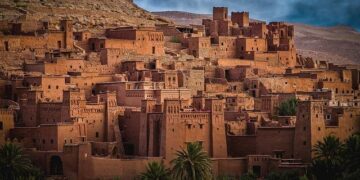Located in west-central Italy, the region of Tuscany is rich in natural beauty. Its striking landscapes vary from the chiselled Tuscan-Emilian Apennines in the north and the rugged Apuan Alps in the north-west, to the gentle green hills of Val d’Orcia in the south.
The region’s capital, Florence, is a destination renowned for its art and architecture. Its most iconic sight is the eminent Duomo, a stunning 400ft-tall masterpiece of the Renaissance. During its 100-year build, architect Filippo Brunelleschi is said to have introduced a pulley system to speed up lunch breaks, feeding the workers on the cathedral’s roof with peposo, a black pepper and beef stew.
Today, food remains an important part of Tuscany’s culture, and visitors are encouraged to slow down and savour the wide variety of culinary experiences on offer across the region — from truffle hunting and cheese tasting to sampling fine wine and sipping fresh coffee — here’s how to get a taste.
1. Join a truffle hunt
Truffles are deeply rooted in Tuscan history, found throughout the region in all shapes and sizes and revered for their distinctive aromas and flavours. Learn about the timeworn traditions and distinct hunting practices of those seeking these subterranean delicacies at Italy’s first museum dedicated to truffles — the Museo del Tartufo e Centro di Documentazione — housed in an old castle in San Giovanni d’Asso. At Cucina Giuseppina, near the town of Certaldo, forage for your own truffles with the help of a guide and trained truffle-hunting dogs, before indulging in a truffle-based Tuscan lunch. In summer, you’ll search for the elusive black truffle, while in the fall, the white truffle is the prize.
2. Try tasty cheeses
Tuscany is best known for pecorino, a sheep’s milk cheese — and especially treasured by Tuscans is the bold-flavoured pecorino cheese produced in Pienza, the aptly named pecorino di Pienza. Elsewhere in the region, the exuberant Palio dei Caci event draws crowds to the town of Volterra each October, where ‘runners’ compete to skilfully guide wheels of pecorino down a cobbled street. Many working farms in Tuscany are open to visitors, too, so you can learn how the cheese is made. Fattoria Corzano e Paterno just south-west of Florence produces cheese, wine and olive oil and also has guesthouses, a farm shop and a restaurant, with tasting sessions available year-round.

Watch competitors skilfully roll wheels of pecorino cheese in the Tuscan town of Volterra during the exuberant Palio dei Caci event, held each year in October.
Photograph by Jim DeLillo, Alamy
3. Make pasta from scratch
Handrolled pici is a popular pasta in Tuscany, often served with tomato, garlic and breadcrumbs. Pappardelle pasta is also a local favourite, generally served with rich and meaty sauces. Join a class to learn how to make your own pasta at wineries such as Magida in Brunello, which also offers accommodation packages. Private cooking lessons are also an option, where you can learn the art of the perfect pasta dish from professional chefs such as Antonella La Macchia.
4. Sample a variety of wines
Tuscany is well known for its geographically protected wines such as Chianti, Montepulciano and Brunello. Stop by the Enoteca la Fortezza wine bar inside the Fortezza di Montalcino and sample Montalcino’s intense and complex Brunello wines. Enjoy tart and spicy Chianti wines at Pietraserena Azienda Agricola Arrigoni in San Gimignano, as you admire the impressive views across the hills and vineyards. Although Tuscany’s established viticulture scene is revered, there are also a growing number of organic, natural and biodynamic wines being developed, helping the region stay at the forefront of Italian wine production. Antinori nel Chianti Classico has been making wine since 1385 and now has an ultra-modern winery attached, which is open to visitors. Or find one of the unique buchette del vino (wine holes) hidden around Florence — at restaurants such as Babae, Belle Donne and Il Latini, to name a few — where wine is served through a tiny window, a tradition that dates back to 1559.

Take a tour of Pietraserena Azienda Agricola Arrigoni in the Tuscan town of San Gimignano to taste their tart and spicy Chianti wines.
Photograph by Sightseeing Experience
5. Experience a traditional trattoria
With charming hilltop towns seemingly around every bend, it’s easy to fall in love with a new local trattoria every evening in Tuscany. On the edge of Panzano-in-Chianti, head to the terrace at Il Vescovino to enjoy homemade ravioli stuffed with leeks and taleggio cheese, served in a simple tomato sauce. Along Tuscany’s western coastline, restaurants such as Il Romito in Livorno serve up a homely fish stew called cacciucco — a 500-year-old dish traditionally made using five or more types of fish in a red wine and tomato broth.
6. Sip freshly roasted coffee
Italy has an affinity for coffee and on almost every corner in Florence you’ll find coffee ‘bars’ in which you can quietly perch to people watch. The city is also home to the Accademia del Caffè Espresso, which features a coffee museum and an indoor coffee plantation, and also offers a selection of educational tasting sessions. Away from the city, learn more about Tuscan artisanal coffee and the finer details of the roasting and blending processes with a tour of Pienza Coffee in Val d’Orcia.

A huge range of delicious food is available at the popular Mercato Centrale in Tuscany’s capital Florence.
Photograph by Jeffrey Blackler, Alamy
7. Peruse local markets
Intense and aromatic, Tuscany’s local food markets are sure to delight — piled high with humble but delicious ingredients, from bread and cheese to tomatoes and beans. While some markets such as Florence’s Mercato Centrale are open daily, smaller towns in the region host their weekly markets on varying days. In the city of Lucca, head to the MercoledìBio on Wednesdays — for organic fruit and vegetables, honey, olive oil, cold cuts, wine, bread and baked goods, as well as sheep’s, cow’s and goat’s cheese — or the Campagna Amica market on Thursdays — for fresh fish and seasonal vegetables, cheese, plants and flowers.
Plan your trip
Direct flights depart daily from most London airports to Florence and Pisa. Regional trains connect Florence to Pisa in under an hour; Pisa to Lucca in 30 minutes; and Florence to Siena in less than 90 minutes. Alternatively, pick up a rental car at Florence or Pisa airports. Guided tours and private driver services are also a great option for exploring Tuscany — for more information, visit sightseeing-experience.com
This paid content article was created for Sightseeing Experience. It does not necessarily reflect the views of National Geographic, National Geographic Traveller (UK) or their editorial staffs.
To subscribe to National Geographic Traveller (UK) magazine click here.
(Available in select countries only).
>>> Read full article>>>
Copyright for syndicated content belongs to the linked Source : National Geographic – https://www.nationalgeographic.com/travel/article/paid-content-taste-your-way-through-tuscany






























